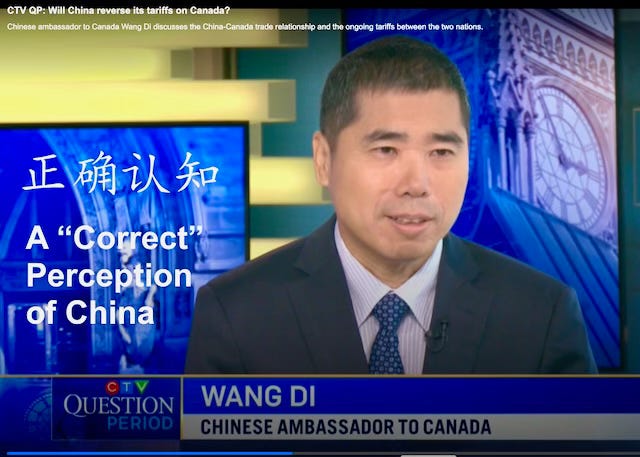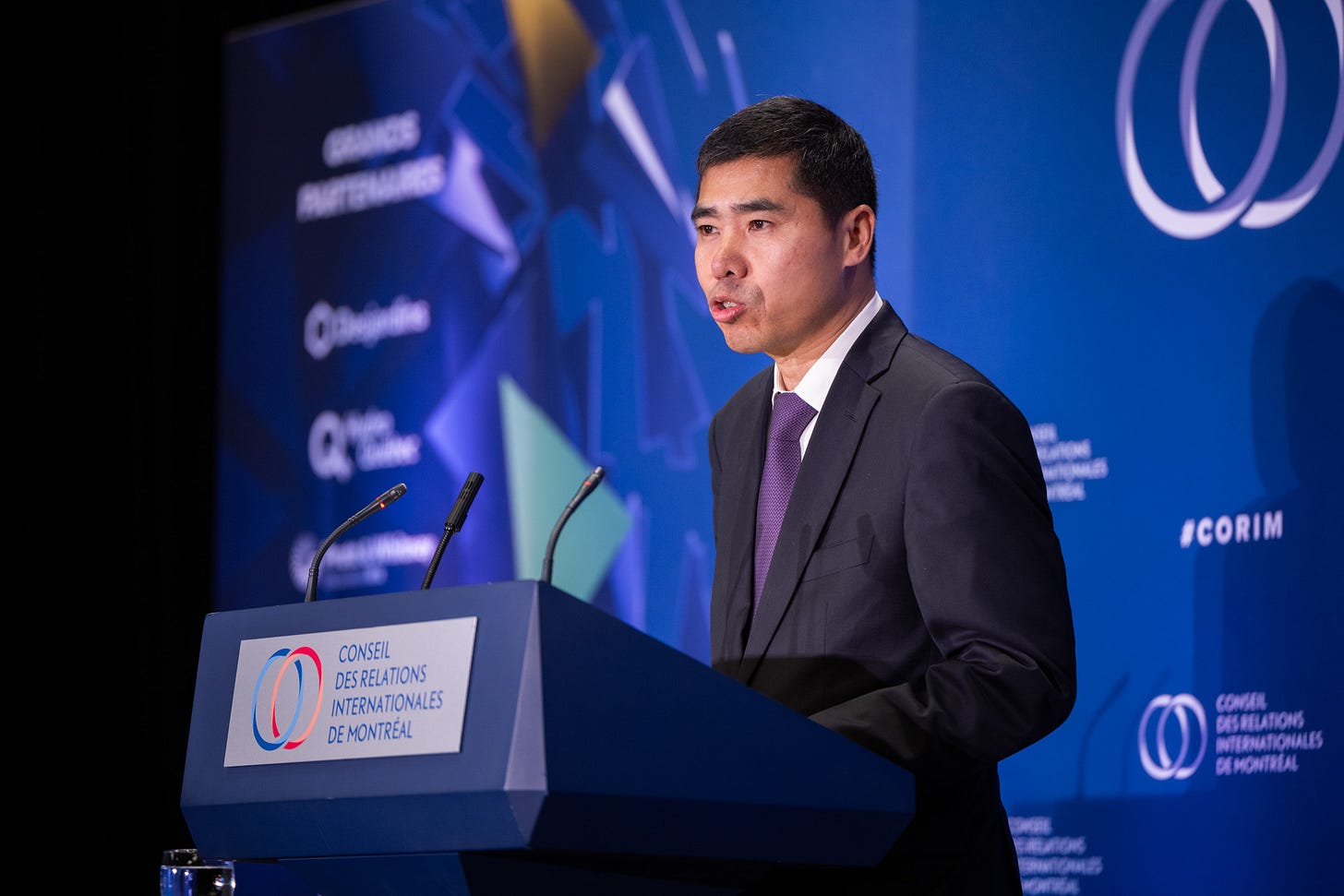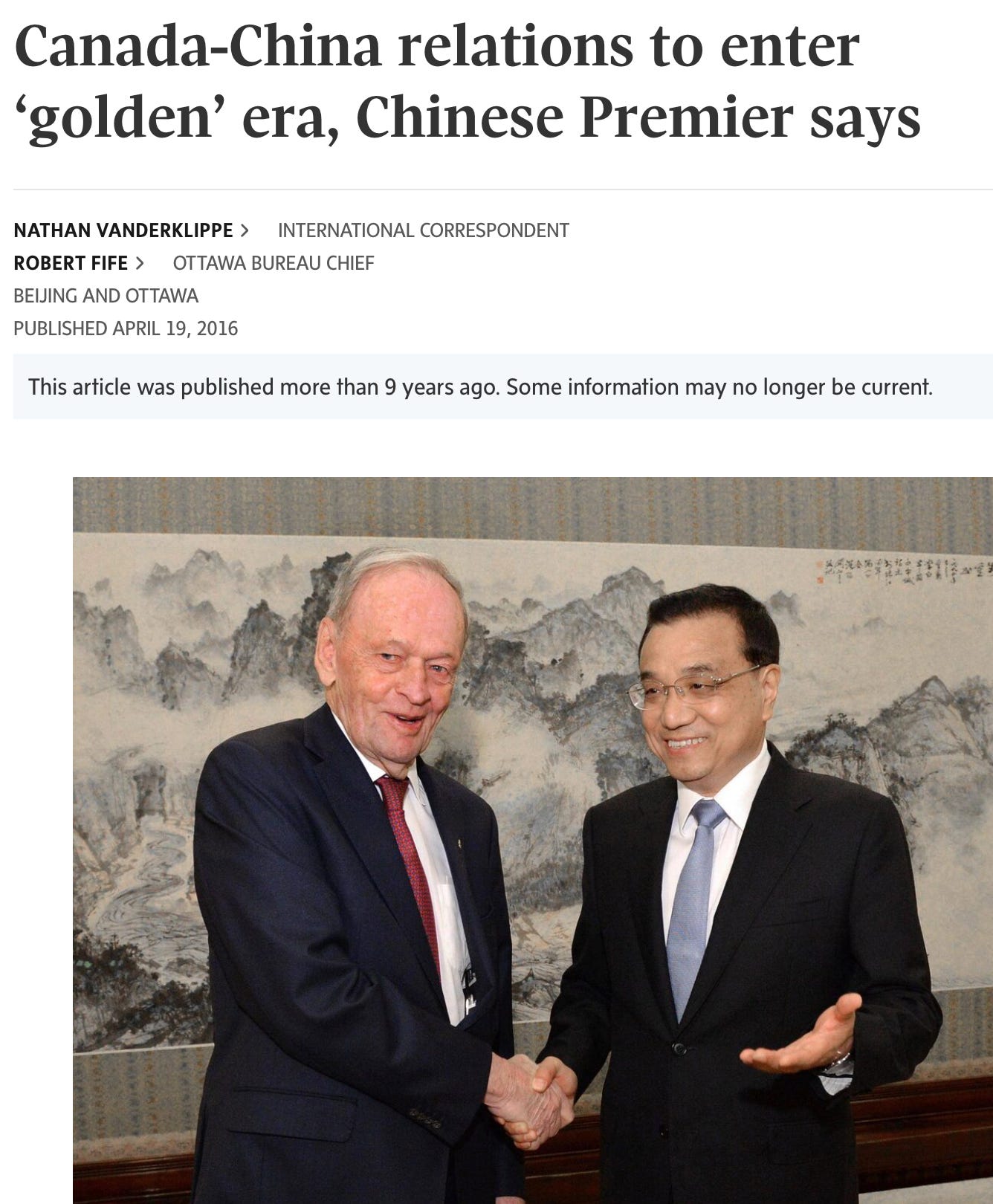A "Correct" Perception of China
It's not the one the Chinese Communist Party wants you to have. That's why it's crucial to decode what its diplomatic slogans really mean.
China’s officials are sweet-talking Canadians. Its Ambassador to Canada, Wang Di, has given smiling interviews calling for the two countries to “have a correct perception of each other.” His other catchphrases include “mutual respect,” “win-win cooperation,” and “positive energy.” Appearing October 12 on CTV’s Question Period, he assured that trade disputes would disappear if only Canada would drop its tariffs.
After enduring several years of China’s abusive “wolf warrior” diplomacy, Canadians — particularly Foreign Affairs Minister Anita Anand, who is visiting Beijing this week — may be tempted to look for comfort in this syrupy language. But they should be wary, because while the Chinese Communist Party (CCP) and its envoys have altered their tone, their hostile intentions and harmful policies remain unchanged. Their goals are to enhance economic ties selectively to create dependence and offload overproduction, while sowing political divisions, both among Canadians and between Canada and its allies.
So when Chinese officials talk, we should listen closely — and then decode the real implications of their words. Case in point: when Premier Li Qiang met Prime Minister Carney in September, he reiterated Ambassador Wang’s call for Canada to show a “correct perception of China” to “cement the political foundation for bilateral ties.”
Correcting Perceptions
The key phrase “correct perception” (正确认知/zhèngquè rèn zhī) encompasses political demands rooted in decades of Communist Party discourse: never question the legitimacy of its authoritarian rule; respect “core interests” like the CCP’s entitlement to rule Hong Kong, Tibet, Xinjiang, and Taiwan; stop supporting American measures to constrain Beijing’s drive to dominate East Asia and reshape the international order; abandon the Indo-Pacific Strategy’s core premise that China is a “disruptive power”; and stop framing the Party-state as a national security threat, systemic rival and violator of international treaties.
“Correct perception” also reflects an ideological tradition that goes back to Vladimir Lenin and Mao Zedong that the CCP has a monopoly on truth. It’s binary. Either you understand it “correctly” and accept its political system and red lines, or you are wrong—and will suffer. General Secretary Xi Jinping has doubled down on this thought control doctrine to impose internal discipline and pump out propaganda narratives.
This is the language of diplomatic gatekeeping, not reconciliation. You want a meeting with Xi? There’s a price. You know what you need to do. First create the conditions (创造条件).
When Ambassador Wang complains of “smearing and attacking on China” about its treatment of Hong Kongers, Uyghurs, Tibetans and Taiwanese, and “attacking and hyping up” its political interference, espionage, and transnational repression, and protests that this harms the foundations of friendship, and indeed “hurts the feelings of the Chinese people” (伤害中国老百姓的感情) — he’s gaslighting people for objecting to injustice, bullying and massive abuses of human rights.
This is rhetorical entrapment, not friendship based on mutual understanding. It’s an attempt to redefine the baseline of the relationship so that criticism is betrayal and the price of cooperation is silence and acquiescence.
Chinese diplomats routinely deploy such coded language. Their well-rehearsed calls for “pragmatic cooperation” and “seeking common ground while maintaining differences” (求同存异) are not proposals to politely disagree. They’re demands to ignore differences on values and national security concerns and prioritize business deals and market access, further enmeshing countries in economic dependency and elite complicity.
When Ambassador Wang says our two countries have “no fundamental conflicts of interest,” he’s insisting we forget about China’s decisive enabling of Russia’s invasion of Ukraine, support for Iran and North Korea, and adversarial behaviour toward other democracies.
Negotiating tip: when Chinese officials declare that two sides “need each other,” it usually signals that the CCP needs something. This year, it’s market access to dump its overproduction of electric vehicles, aluminum and steel.
These nuggets of Party-speak are also being dispensed to audiences in Australia, New Zealand, Japan, Europe, and elsewhere, who have experienced a superficial charm offensive since late 2022. (Canada’s was delayed until Justin Trudeau departed the scene.) By portraying China’s government as a responsible pillar of international order and blaming all problems on Washington, Chinese officials hope to benefit from America’s belligerent turn and lull other countries into complacency about their own drive for geopolitical primacy.
The message is that partnership with China requires accepting your place in a Beijing-centric global hierarchy. Unmentioned is that much of Donald Trump’s ire with the global trading system stems from the massive distortions forced upon it by China’s mercantilist, state-guided economic policies. Those same distortions are behind the PRC’s trade disputes with Canada.
In his October CTV interview, Ambassador Wang even redeployed the old Chinese proverb, “the one who tied the knot should be the one who unties it” (Wang spoke Mandarin and the actual proverb he used was “解铃还须系铃人”— he who tied the bell (on the tiger) must untie it) to argue that “China is not the one to blame.” In his narrative, Canada is the wrongdoer because it imposed tariffs and hurt China’s EV producers, and Beijing is fairly and righteously defending itself by blocking canola and other agri-food.
It’s more diplomatic gaslighting: invert blame, pose as the aggrieved party, and hold out the prospect of reconciliation. In reality, Canada’s tariffs are a necessary alignment with Washington to preserve an integrated automotive industry and foster nascent domestic EV production. They’re also more than justified by the need to counteract industrial policies that may add up to a staggering four percent of China’s GDP, have warped its economy and are now engineering its overwhelming dominance in advanced technologies and global manufacturing supply chains. The CCP has tied all of us in this knot.
As Anita Anand takes her first trip to China as foreign minister, her interlocutors may try to sell her another Chinese proverb: “get on the train first, buy the ticket later” (先上车后补票). We can have immediate pain relief if Ottawa drops duties, while the hidden costs to the country’s manufacturing base and sovereignty pile up slowly during other politicians’ watches. Don’t be surprised if the Chinese then come back looking for more concessions.
If Beijing really wants to repair the relationship, it should begin by untangling its own knots: stop using coercion, exporting economic distortions, interfering in Canada’s politics and society, helping Russia kill Ukrainians, and demanding ideological and systemic acquiescence.
The Communist Party is unlikely to do any of those things. Party-state officials may be willing to change how China is perceived by adjusting style and making reversible, targeted economic gestures when they find it expedient to do so. Causing them to change their political culture, worldview and intentions, and the substance of the policies that flow from them, would be challenging, to put it mildly.
So what should Canadians do? Don’t get stuck in the syrup. Decode the slogans. Remember that the CCP’s charm can turn to menace in a heartbeat. Don’t relinquish leverage. Increase efforts to articulate our own core values, strengthen our sovereignty, and diversify and deepen relations with more reliable partners. Only then can we maintain our freedom to form our own “correct” perceptions.
First published in Canada’s National Post 15 October 2025. This version adds details, links and below, a deeper dive.
Perception Diplomacy: Decoding Beijing’s Envoys
Beijing’s rhetorical softening toward Canada fits into a wider “second charm offensive,” which we might describe as “rectification of perception diplomacy” (正确认知外交). The 正确认知 phrase debuted in November 2023 when Xi met President Joe Biden in San Francisco (translated then as “right perception”), where Xi presented it as the first of five pillars for China-US relations. Since then China’s envoys have been diligently echoing their boss while adjusting the usage slightly to show they’ve internalized it. Another formulation is to “view rationally” (理性看待). Similar talking points have appeared in Chinese outreach to the EU, Australia, and the UN system—emphasizing “mutual respect,” “diversity of development paths,” and “win-win cooperation.”
This positive language and friendly tone, while manipulative, is still vastly preferable to wolf warrior abrasion, coercion, insults, bullying, weaponized interdependence, hostage diplomacy, and so on. The dangers are more subtle when you can’t see the crouching tiger and the dragon is hidden. Each communication mode needs to be decoded.
As China’s former ambassador to Sweden, Gui Congyou, once said, “We treat our friends with fine wine, but for our enemies we have shotguns.” The trouble is that the trip from one status to the other can take an express elevator. The same Party-state officials who smile on TV will just as quickly throw you in the doghouse. Just ask Australia.
The “Canada-China Dance”
Ambassador Wang uses “correct perception” regularly, notably in a November 2024 speech at the Montreal Council on Foreign Relations, in which he said “problems in China-Canada relations all resulted from mis-perception.” Mmm hmm. Let’s talk about 1,019 days of misperception…
The speech is explicit about the deal the CCP is offering: “Politics and national security should not be the excuse of not advancing practical cooperation.” It comes down to what kind of people you’re willing to do business with. Borrowing a metaphor from Canada’s Ambassador to China, Jennifer May, he added that “since we are dance partners, we can dance beautifully only if both sides show goodwill and dance in step with each other.” But who leads and chooses the music in this ballroom?
“China-Canada relations: setting sail toward a brighter future”
This week, Wang published an op-ed in The Hill Times with the above title. Clearly he’s been tasked with engineering a reset — without the CCP acknowledging or redressing any past wrongdoing, or changing any of its current harmful behaviour. In addition to “correct perception”, his article, speeches and interviews recycle the following misleading or multilayered examples of Party-speak.
1. Seek Common Ground While Shelving Differences (求同存异)
Meaning “we’re willing to work with you where our interests align — but don’t try to change us, and don’t expect us to compromise on what we define as non-negotiable. Let’s maintain a cooperative facade, even as our systems diverge.” China’s officials typically use it when they want to de-escalate tensions, particularly with Western countries. It signals pragmatism, but also sets boundaries. It can also be a delaying tactic while China shapes the terms to be more favourable.
The intention is to find areas to cooperate, but don’t demand ideological convergence. Let’s work together on shared interests (common ground) even if we continue to disagree on values, systems, or narratives (differences). Subtext: It’s an appeal for tactical cooperation without political transformation. It encourages engagement while rejecting liberal norms.
“Reserving differences” can also imply deferring resolution indefinitely, especially if China benefits from the status quo. It buys time, avoids confrontations it’s not ready for, and signals China will not compromise on “core interests”— but may engage elsewhere. For example, China has used the phrase with ASEAN in negotiations over the South China Sea — promoting regional cooperation while delaying legal or territorial concessions. At the UN, Chinese diplomats use “seeking harmony but preserving difference” to appear constructive while reshaping multilateral norms.
2. No Fundamental Conflict of Interests
This line appears often in China’s outreach to Western countries—though not with the United States. It’s a wedge tactic: we can get along just fine; the real problem is Washington. The message to US allies is that those disputes are bilateral and shouldn’t concern them—a convenient fiction that seeks to split the Western consensus while isolating America. This narrative encourages middle powers like Canada to pursue “independent diplomacy” and “variable geometry engagement” that fragments Western coordination.
3. Practical/Pragmatic Cooperation and Mutual Benefit
This assumes that common interests always exist and merely need to be “discovered.” But “pragmatic cooperation” usually becomes conditional cooperation: China offers economic incentives expecting political reciprocity. To reap “mutual benefit,” countries are encouraged to align their diplomacy with Beijing’s priorities—whether by limiting ties with Taiwan or voting with China at the United Nations. This is “coercive interdependence” in which the PRC combines access promises with selective punishment to “re-incentivize” partners who drift politically. (See more at Decoding China)
4. Defend the International Order and Uphold Multilateralism
Like his colleagues, Wang says we should “uphold the post-war international order.” One might assume that to be the same liberal rules-based order the CCP has been undermining, exploiting and subverting for the past few decades. Sadly no. It’s China’s own illiberal counter-order.
America’s own cultural revolution and wolf warrior phase have opened the door for China on this one. Can’t really blame Chinese officials for waltzing through it. But is there anything in Xi’s Global Governance Initiative that would be genuinely pleasing to open societies? As multiple studies document, Beijing delays its UN dues payments for leverage, is expanding control of UN Secretariat staffing, and coordinates with Russia to block human rights mandates.
This CCP model of “sovereign multilateralism” reinterprets cooperation as consensus on state control rather than shared values. The purpose is to promote Xi’s Sinocentric vision of multilateralism, the “common destiny for mankind” or “shared future for humankind” (人类命运共同体). The Chinese term (renlei mingyun gongtongti) is often deliberately mistranslated as a “community” but analysis of its internal Party-state use shows it really expresses a hierarchical cosmology of Tianxia (天下) — all under heaven — in which China is the central and preeminent state.1
5. Earnestly Implement the “Consensuses”
Wang Di concludes his op-ed with a call to “earnestly implement the important consensus reached by the leaders of the two countries.” What consensus?
In his 2024 Montreal talk, Ambassador Wang also said then-Foreign Minister Melanie Joly and State Councillor Wang Yi had “reached a number of consensuses” when they met in July 2024. Such “consensus” framing was notably absent from the Canadian meeting readout. More recently, on their June 5, 2025 phone call, in the PRC Foreign Ministry’s formulation, Premier Li Qiang and Prime Minister Carney agreed to:
restore high-level dialogues and exchanges;
adopt a more “objective and rational” attitude in bilateral relations;
deepen cooperation across diplomacy, economy, trade and other fields;
and emphasize respect, equality, and mutual benefit as guiding principles.
This year Xinhua referred to the Li-Carney “consensus” when Foreign Minister Anita Anand met Wang Yi on July 11, 2025, and Wang also called for “adopting a more objective and rational attitude towards each other and strengthening cooperation with a more positive and open spirit.” (That would be great if it involved actual behaviour change by China.) In all cases, only China says there’s consensus, and no joint statements have been released.
This is a classic Chinese tactic: issue a statement that fits the Party narrative, then claim both sides agreed to it. The other party’s silence or polite phrasing becomes retroactive endorsement. Similar phrasing has appeared after Xi’s meetings with EU leaders and in joint communiqués at the UN.
Shaping the Narrative to Control Reality
These soft-spoken appeals are not a new openness. They are a tactical recalibration within the same CCP three information warfares doctrine: shape the conceptual terrain first, then negotiate on it. In diplomacy as in discourse, whoever defines the “common ground” controls it. The Party makes its own reality.
In the spirit of Ambassador Wang’s friendly rhetoric, I hope that he and his comrades correctly perceive this analysis as “helpful advice and well-intentioned criticism” and not “condescending lecturing” or “ill-intentioned smear and attack.” I would love for China’s government to become the friendly, supportive and trustworthy partner portrayed in its current charm offensive.
One more thing: remember this headline from 2016?
“Some information may no longer be current.”
Talk is cheap. Misinterpreting it can be costly.
Thanks to Patricia Xavier for stellar research assistance, and Joseph Widacki and Jonathan Landreth for further support and input.
For a deeper examination, see Steve Tsang and Olivia Cheung, “Building ‘the Common Destiny for Humankind”, in The Political Thought of Xi Jinping (Oxford, 2024) pp. 168–193.




